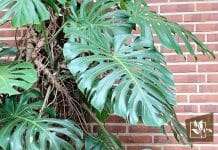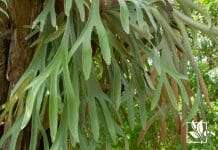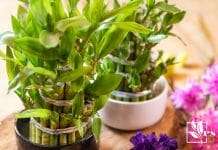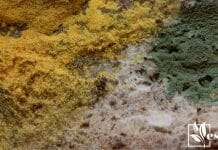Do you get the feeling that something is eating your basil, and it’s not you?
There are several bugs eating basil, both inside and out. And it’s not just bugs that could be to blame.
Besides notorious basil insects, you might find some larger critters nibbling on your crop. With that in mind, let’s take a look at the top 9 culprits and how to deal with them.
What Is Eating Your Basil Plants?
⚡️ Insects are most likely eating your basil plants. Here are the most common culprits: slugs and snails, caterpillars, aphids, bush crickets, Japanese beetles, leafhoppers, leaf miners, and spider mites. Occasionally, pets and other small animals may also be nibbling without you noticing.
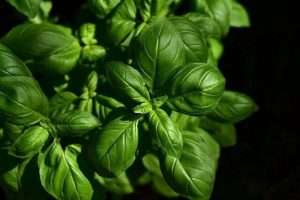 Basil plants are very aromatic. Its leaves have high concentrations of linalool and estragole, two compounds that are used to make fragrances. The leaves also produce eugenol, an aromatic blend that makes basil leaves tasty to us but unpalatable to most bugs. Basil oil is often used as an insect repellent. Many gardeners use basil as a companion crop to protect their plants from pest attacks.
Basil plants are very aromatic. Its leaves have high concentrations of linalool and estragole, two compounds that are used to make fragrances. The leaves also produce eugenol, an aromatic blend that makes basil leaves tasty to us but unpalatable to most bugs. Basil oil is often used as an insect repellent. Many gardeners use basil as a companion crop to protect their plants from pest attacks.
Generally speaking, basil should not attract too many bugs or insects. However, that doesn’t mean that basil is invulnerable to pests.
If you’re wondering, here’s a list of insects that eat basil leaves and are the most likely culprits:
- Slugs and snails
- Caterpillars
- Aphids
- Bush crickets (katydids)
- Japanese beetles
- Leafhoppers
- Leaf miners
- Spider mites
- Pets and other small animals
Let’s take a closer look at how to identify each one:
1. Slugs and Snails
Slugs and snails are a common problem with basil grown in the garden. They usually come out during the night, and especially after the rain. To identify their visit, look for small, round holes along the leaves’ edges or a silvery trail of mucus on stems and leaves.
Slugs and snails can be efficiently dealt with, but you have to be quick. These pests can devour an entire basil plant in no time, especially when they’re in large numbers.
2. Caterpillars
Caterpillars come in many shapes, sizes, and colors. They are usually the larvae of various butterfly and moth species, such as the cabbage looper, cabbage butterfly, large yellow underwing (cutworm), or the beet armyworm.
One thing they all have in common is the fact that they love munching on your basil leaves. They are straightforward to spot: look for holes in basil leaves, or chewed edges, or leaves that are rolled up and fastened with silk.
3. Aphids
 Aphids are one of the most common basil pests for both plants grown indoors and outdoors. They are usually black or green and form large colonies along the stems and under the leaves, close to the veins.
Aphids are one of the most common basil pests for both plants grown indoors and outdoors. They are usually black or green and form large colonies along the stems and under the leaves, close to the veins.
Aphids feed by sucking the sap from the leaves, causing them to turn yellow and wilt. In the process, they will secrete a clear, sticky substance, which ants immensely enjoy. Ants often ‘farm’ aphids, effectively protecting them from predators while they produce this sweet ‘nectar.’
4. Bush Crickets (Katydids)
Bush crickets, commonly known as katydids, look very similar to grasshoppers, although they are usually smaller. Both the adults and nymphs eat leaves, and in some cases, they can also eat fruit and even aphids.
Katydids are primarily active at night, and you can usually hear them ‘chirping’ late in the summer. Although bush cricket infestations are pretty rare, these basil plant bugs can deal some severe damage when hungry.
5. Japanese Beetles
This species of scarab beetle is easy to identify by the metallic, brown, and green color. They are pretty small, usually around 0.6 inches (15 mm) long. Japanese beetles can be very destructive, especially in summer.
No part of your basil plant is safe from them, with larvae eating the roots while the adults devour the leaves. If your basil leaves have been chewed on, but the large veins have been left intact, that’s a clear sign of Japanese beetles visiting them.
6. Leafhoppers
Leafhoppers are tiny insects that suck the plant sap from basil leaves. They are usually around a ¼ inch in size (around 6 mm) and live underneath the leaves, clustered around the veins.
Leafhoppers can be challenging to spot, but they can deal a lot of damage if left unchecked. Signs of leafhopper infestation include curling leaves, turning yellow around the edges, and having a scorched look, a symptom often called ‘hopper burn.’
7. Leaf Miners
Several species of bugs are eating basil leaves classified as leaf miners, from moths and flies to beetles. They have in common the feeding habit of the larvae, which dig tunnels inside the leaves as they eat.
Leaf miner damage is straightforward to identify: the leaves will be covered in squiggly lines and patterns. In severe cases, it will turn yellow and brown.
8. Spider Mites
Spider mites can be a real nuisance, especially if they’re detected too late. These tiny bugs live under the leaves, sucking the sap and producing a spider-like web that protects them as they feast.
The most common sign of a spider mite infestation is leaves that are developing small, yellow, or brown spots or leaves that are starting to curl. Check the underside of your basil leaves every week, and take action immediately if you notice the webs.
9. Pets and Other Small Animals
It’s not just bugs and insects that are eating your basil plants. If you have pets, especially cats, they will be very tempted to take a bite out of the leaves. Basil grown in the garden can also be eaten by wild birds, rats, or possums.
Luckily, keeping small animals away from your basil is more manageable than protecting it from insects. For basil grown indoors, the best solution is keeping it out of reach of pets, on a windowsill, or other tall surfaces. In the garden, try using netting or wire mesh held up by a support system, which should keep most of the four-legged visitors away.
How To Keep Bugs From Eating Your Basil Plants
In this guide, we’ll recommend a few remedies you can use to keep your basil plants safe without resorting to harsh chemicals.
1. Slugs and Snails
Slugs and snails can deal a lot of damage, but they can also be easy to deal with. What we recommend is to prepare a bucket of soapy water and head into your garden late in the evening, especially after the rain.
Check each plant, manually pick up the snails and slugs, then throw them into the soapy mix. Alternatively, you can also create a ‘barrier’ around your basil plants by spreading coarse materials such as crushed eggshells and sawdust or coffee grounds.
2. Caterpillars
Like slugs and snails, caterpillars have plenty of natural predators. Songbirds, frogs, some species of wasps, even ladybirds are always on the lookout for these tasty pests, actively working to keep your basil plants safe.
You can also pick them up by hand and remove them in a bucket of soapy water. Another solution is to spray the leaves with a solution containing Bacillus thuringiensis. These non-toxic bacteria dissolve the caterpillars’ stomach when ingested.
3. Aphids
Aphids can be very tenacious, especially when they have ants protecting them, but luckily, they are easy to manage. They are favored prey for ladybugs, soldier beetles, lacewings, and aphid wasps, which help keep their numbers under control.
For potted basil, the easiest way to get rid of aphids is to wash the plants with a hose or under the tap, which will dislodge their colonies. You can also spray the leaves with a solution of neem oil or other essential oils.
4. Bush Crickets (Katydids)
Although it’s unlikely you’ll have a katydids infestation in your garden, it’s best to be on the lookout for these pests. Birds and other small predators will eat the adults and nymphs.
You can also spray the basil leaves with a neem oil solution (it will leave a weird smell due to the neem oil) or a homemade hot pepper and garlic spray. The unpleasant taste of the treated leaves will discourage the nymphs from eating them.
5. Japanese Beetles
Adult Japanese beetles can be picked up by hand and discarded in a bucket of soapy water. To protect the leaves, spray them with neem oil or cedar oil solution, which should give them a bitter, unpalatable taste.
Getting rid of the larvae living in the soil can be a bit tricky. We recommend using beneficial nematodes, which are best applied in spring, before any chance of infestations. You can also use sprays containing Paenibacillus popilliae. These bacteria cause the milky spore disease in the Japanese beetle grubs.
6. Leafhoppers
One effective way to protect your basil plants from leafhoppers is using diatomaceous earth. This natural rock is typically sold in powder form. Spread it around the base of the plants to keep adults at bay.
You can also spray a Kaolin clay solution on the stems and leaves, which will cover them in a powdery layer that irritates both adult insects and nymphs. The nymphs also make a delicious meal for ladybugs or minute pirate bugs, which can be used as organic pest control.
7. Leaf Miners
Leaf miners can be challenging to get rid of because the larvae eat the leaves from the inside. This way, they are protected from natural predators, and insecticidal sprays are applied directly to the leaves.
In this case, prevention is the best cure. Spray the leaves with neem oil or an organic insecticide in early spring before the adults have had a chance to lay eggs. Also, cut any infected plants and burn them, to prevent these pests from spreading.
8. Spider Mites
Spider mites are not insects but are more closely related to spiders and ticks. As a result, they don’t respond to insecticides and pesticides the same way most bugs would.
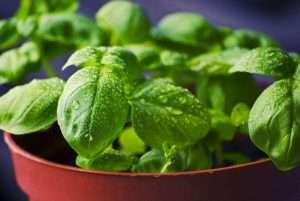
The best homemade solution we’ve used to eliminate spider mites is a mixture of water and isopropyl alcohol. Mix 1 part alcohol and four parts water, and spray it on the bottom of the leaves once a week. Make a fresh solution each time and repeat the application for a month until there’s no more sign of these little pests.



